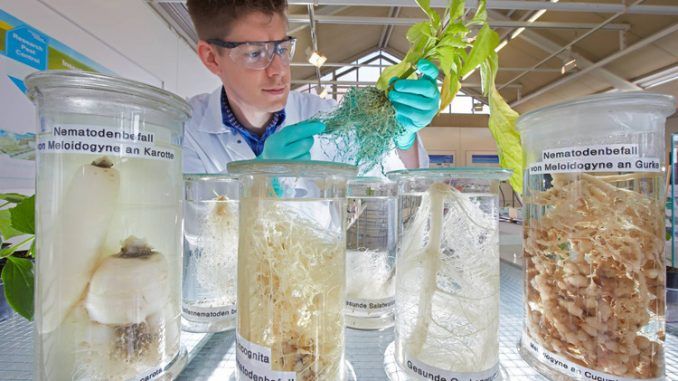
One little worm may change the future of cancer research forever, says Marijn Dekkers of Bayer AG.
From AGWeb:
Nematodes, which gnaw at peanut and cotton roots, first drew Bayer’s attention for destructive purposes. Researchers devised an insecticide that starves them of oxygen to wipe out a pest blamed for $100 billion in crop damage every year. But when the scientists shared this suffocation approach with pharmaceutical colleagues, a curative potential came into view: a pathway that might also work to throttle cancer cells.
Although a plant and a human look different, many mechanisms are driven by the same chemistries.

BYPASS THE CENSORS
Sign up to get unfiltered news delivered straight to your inbox.
You can unsubscribe any time. By subscribing you agree to our Terms of Use
Mining the overlaps between plant, people and pet research is a growing part of Bayer’s strategy now that the 150-year-old German company is exiting the plastics business–and one that puts it at odds with many fellow drugmakers. Dekkers, Bayer’s chief executive, points to a revolution in research tools like gene sequencing to explain why the cross-species strategy can deliver now, a decade after Novartis AG, AstraZeneca Plc and Sanofi deemed it a failure.
“Bayer was stubborn and didn’t do that,” Dekkers said in an interview in his fourth floor office at Bayer’s headquarters in Leverkusen, Germany, the industrial city that flanks the Rhine river halfway between Cologne and Duesseldorf. “And in my mind, this will be an enormous advantage.”
Dekkers, 57, is taking a transformative step this year by splitting off Bayer’s plastics unit, ending a century of producing materials used in cars, construction and electronics.
The more audacious move, though, may be the company’s return to a concept once known as life sciences, which Novartis founder Daniel Vasella first wrote off in 2000.
To show why they’re bucking the trend, Dekkers and Kemal Malik, Bayer’s head of innovation, recount the nematode story, in which scientists found that blocking the delivery of oxygen to worm cells yielded a pathway that could be mined to cure people and pets.
So far that research has spawned a single pesticide introduced in February for cotton and peanut crops. Scientists at Bayer’s labs in Berlin are now exploring the same pathway to stifle the most dangerous form of skin cancer in humans as well as heartworm, blamed for congestive heart failure dogs.
The remainder of what Bayer has to show for its efforts so far is either so tentative it may take years to enter clinical tests or so old it predates the birth of a two-year-old cross- pollination effort named the Nimbus Initiative after Harry Potter’s favorite brand of flying broomsticks.
Some Doubts
The early collaborations include research on proteins that can act as building blocks for new drugs. Older products that take advantage of the species overlap (humans share about 90 percent of genetic information with cats and dogs and 18 percent of DNA with weeds) include the crop insecticide Gaucho, whose active ingredient is also used to kill fleas in the pet product Advantage.
“The new element now is doing this in a much more systematic way with a real data-driven backbone,” Liam Condon, who heads Bayer’s crop unit, said in an interview. The goal is also “to develop products in parallel and not sequentially.”
To that end, a team of more than 200 experts in computer science, statistics and engineering is analyzing data gathered through all research efforts, according to Condon.
Not everyone is convinced the effort will deliver. Markus Manns, a fund manager at Union Investment Luxembourg SA, which holds 1 percent of Bayer, says he likes the strategy because the units balance each other in terms of risk and growth, and shield the company against takeovers. Not because of any research symbiosis.
“The synergies between pharma and crop science are minimal, especially in the area of research and development,” according to Manns. “There are definitely more synergies between animal and human health, but not many.”
Robot-Run Library
Healthcare, which includes products for animals and humans, ranked as Bayer’s biggest unit last year with 20 billion euros ($22 billion) in revenue. Yet the smaller crop chemicals unit, with 9.5 billion euros in sales, is the faster growing one.
Bayer’s share performance suggests investors endorse Dekkers’ strategy. The stock has risen 19 percent so far this year, outperforming Novartis, AstraZeneca and Pfizer Inc. and making Bayer Germany’s most valuable company ahead of Volkswagen AG.
The expanded collaboration has also meant combining compound libraries containing the basic ingredients of future drugs. Bayer’s robot-run libraries contain 4 million compounds, including 600,000 newcomers from the crop chemicals unit. The last step of this merger was completed last year.
“We were very siloed until then,” said Dekkers. “Even though a plant and a human look different, many mechanisms at the cellular level are driven by the same fundamental chemistries. So which species it happens to be is actually not so important.”


